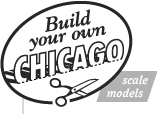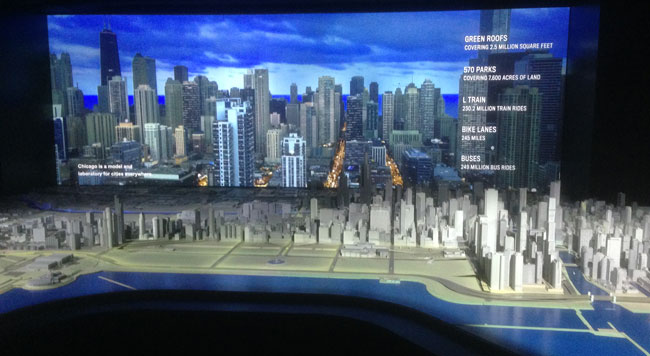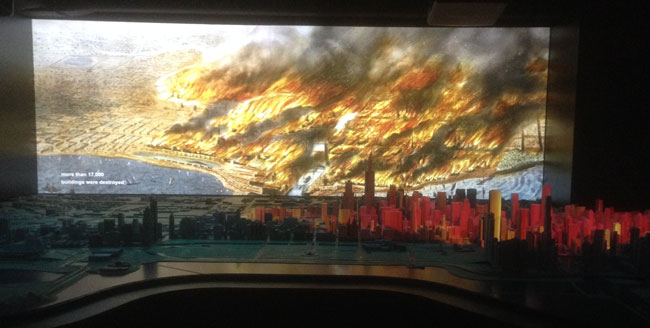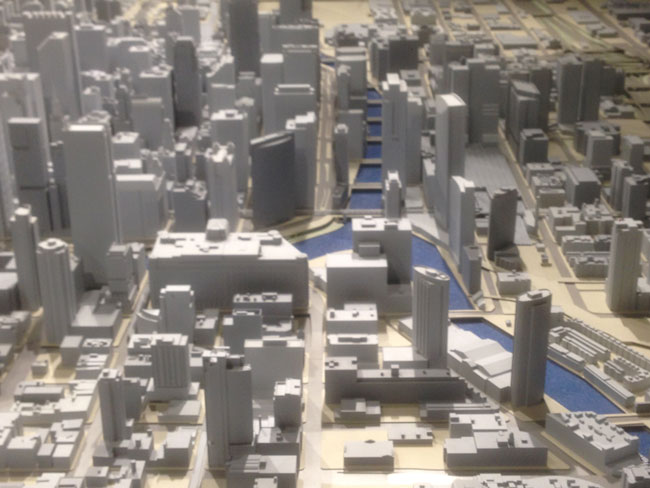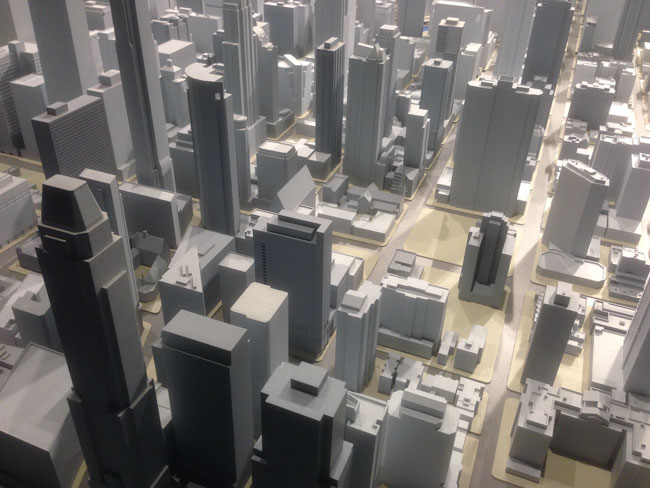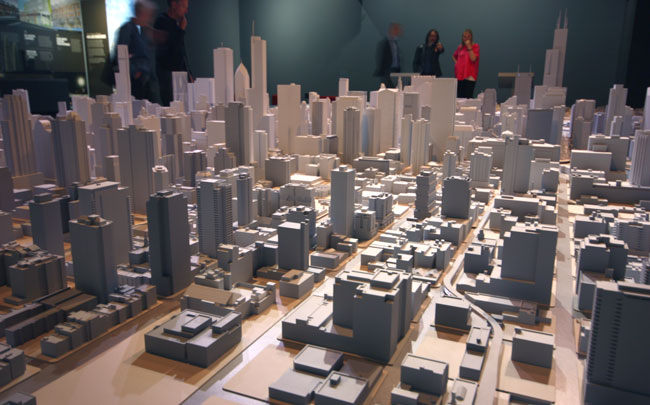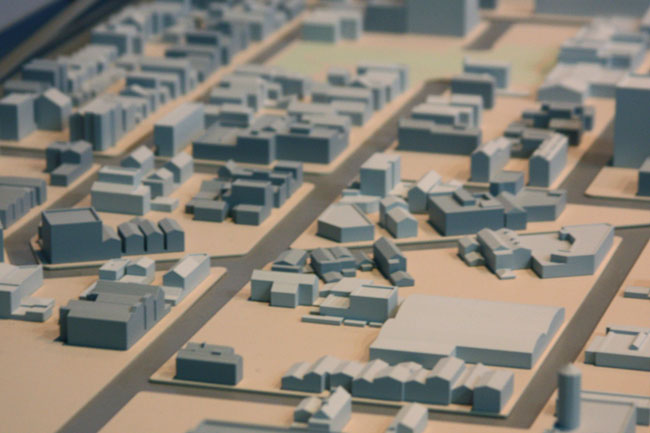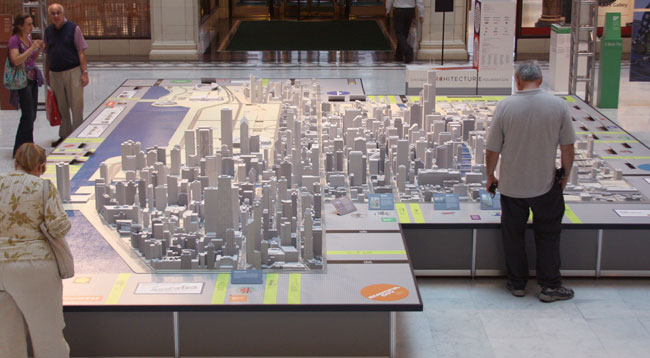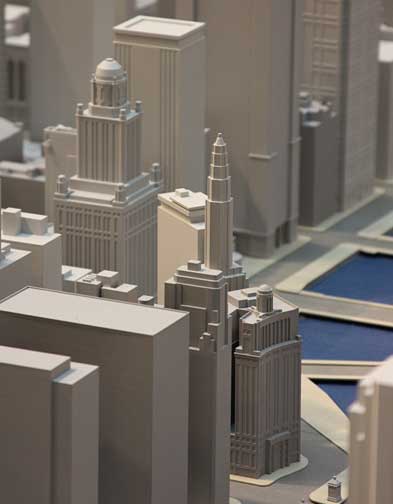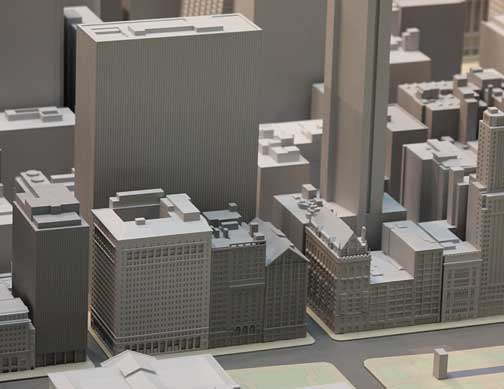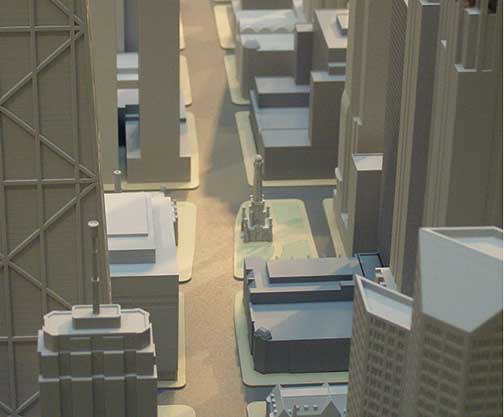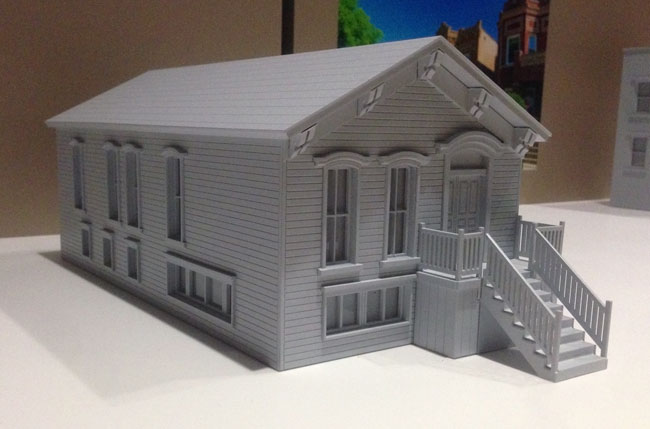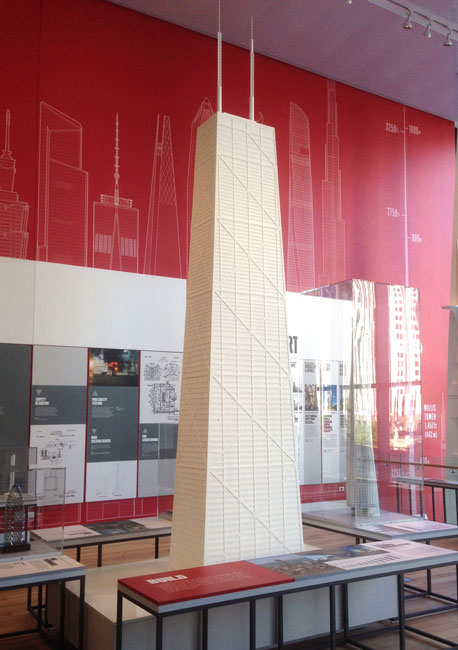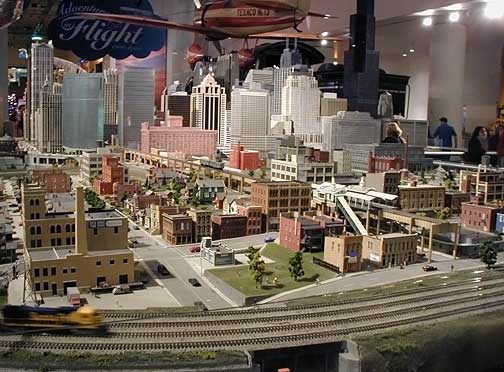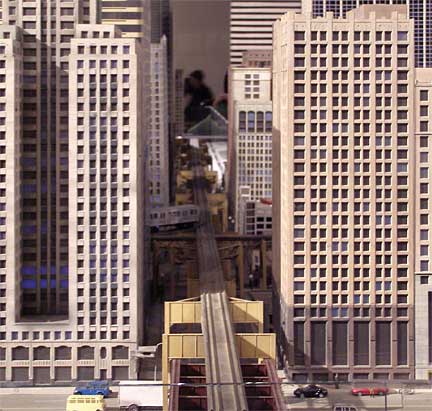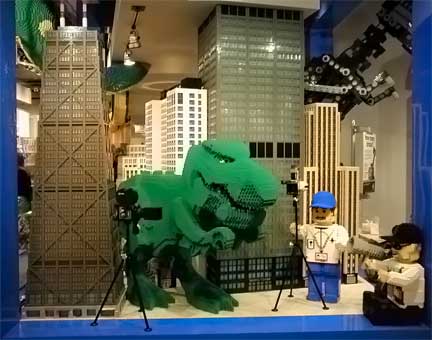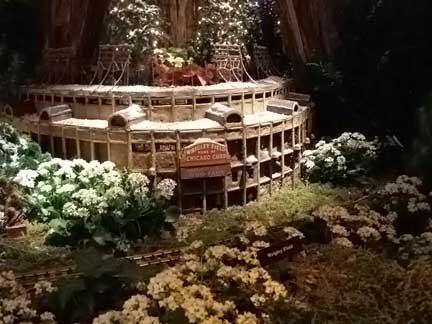|
At the Chicago Architecture Center there is a 1:600 (1"=50') scale model of downtown Chicago. The Chicago Model depicts 630 blocks of the center part of the city, from Cermak on the south to Oak Street on the north, from Lake Michigan to Sangamon on the west, about 3.3 x 2.3 miles of the city. At this scale, the model is about 30 feet by 20 feet, or roughly 600 square feet in size.
The model was created in 2009 for an exhibit celebrating Daniel Burnham's 1909 Plan of Chicago, one of the first comprehensive attempts at city planning. After the exhibit closed the model remained on view in the atrium of the Santa Fe building outside the Chicago Architecture Foundation offices for many years and became a popular landmark for tourists and architectural walking tours. In the fall of 2018 the model was moved to the new home of the Chicago Architecture Center and is now only viewable by members of the CAC or architecture-tour ticket-holders. The new model was enlarged by almost 50% in scope, and over 3,200 new buildings were added.
The model is no longer displayed in the round as it was previously. Instead a screen blocks off the western edge of the miniature city. Every 20 minutes an 8-minute movie retells the story of the growth of the city and its innovations in architecture. Computer-contolled lighting is used to spotlight places mentioned in the movie to make a multi-media presentation. In between screenings of the film, viewers can touch screens at the sides to see information about infrastructure and architectural themes which are then highlighted using the lighting system on the model.
The scenes of the 1871 Great Chicago Fire in the film are especially dramatic, as the mythological city is reborn from the ashes.
For visitors simply wishing to get lost in the tiny streets and take an imaginary walk throught the miniature city, the repeating movie can be a bit frustrating, as during the film the lights in the gallery are lowered and its impossible to do anything but watch the presentation. The 12 minutes in between showings do give some time for exploration, but whenever a visitor touches one of the nearby screens, the lights again dim to point out through colored lights some aspect of infrastructure and the miniature wanderer must wait again. Even when the lights are brought up between these moments, it is still dim in the gallery and difficult to take clear photos of the model.
Even so, the large number of buildings in the enlarged model make for an impressive sight. In the dim light the jumble of skyscrapers and low buildings around North State Street look like some miniature set from Blade Runner or other sci-fi movie.
Columbian Model & Exhibit Works created the individual buildings in resin by stereo-lithographic 3D printing using 3D Sketchup digital models. After printing, the translucent resin models were sanded and painted in various shades of grey so that each building can be differentiated from another. Every six months the model is cleaned and updated to reflect current developments and changes in the city.
The expanded scope of the model includes a bit more of the neighborhoods outside downtown. In the two previous photos, high-rise apartments encroach on older areas of low buildings in River North and farther north, but to the west and south of downtown the scale of development quickly decreases to tiny individual houses and two-flats typical of Chicago's sprawling neighborhoods. The diagonal street in the above photo is Canalport in the east side of Pilsen, an area with many masonry houses dating to the 1870s and 1880s. The scale of the model is large enough to include a lot of detail of these buildings. It would be interesting to see the model continued to the full extent of the city, with tiny neighborhoods like this in every direction. To include the entire sprawl of the city at this scale would require a model 230 feet long by 189 feet wide! Here are a few photos of the smaller 320-square foot version of the model which was on display from 2009-2018. The central parts of the model have not changed too much aside from some updates of a few new buildings.
When the model was on display under a large skylight in the atrium of the Santa Fe building it was easier to photograph small details of the buildings:
The one shiny object on the model amidst all the gray structures is the "Bean" or Cloud Gate sculpture in Millennium Park.
Some of the models seem to be built with a higher level of detail than others. But perhaps its just that the older skyscrapers have more surface detail than the plain Miesian boxes of Illinois Center in the foreground of the photo above.
Behind the Michigan Avenue "Streetwall" of early twentieth-century skyscrapers loom massive towers such as the 1972 Mid-Continental Plaza. The top 10 floors of this office building were converted to condominiums in 2013 and the thin windows reclad with larger glass and balconies. The model was updated with a new scale miniature building at that time depicting the new appearance of the building.
The 1869 Water Tower is nearly hidden among the many skyscrapers which now dominate North Michigan Avenue. Its a challenge to find the tiny landmark on the model. The expansion of the Chicago Model to include city neighborhoods allowed the Chicago Architecture Center to add info about the residential architecture that typifies the city more than the skyscrapers of downtown. In a display near the model there are some larger-scale models showing house styles such as this typical workers cottage which is perhaps similar to some of the tiny buildings in Pilsen seen in the city model:
One of the other highlights of the CAC are the many large skyscraper architectural models which are on display in the upstairs gallery. Chicago architectural model-making firm ModelOptions created nine of these depicting the world's tallest skyscrapers for an exhibit highlighting Chicago's connection to their design and engineering. The models were created to a consistent scale of 1:1092 or 1" = 91' and are made of foamcore and plastic to be lightweight despite their size. The tallest model of the Burj Khalifa spans two floors of the exhibit and stands nearly 30 feet tall. The John Hancock Center here is more than 12 feet high (not including the antennae). The diagrams of other tall buildings on the back wall are drawn to the same scale for comparison.
There are several other notable city models in Chicago. At the Museum of Science and Industry, The Great Train Story is a large model railroad layout in HO scale (1:87). A long loop winding through the model simulates the sights along a train journey on the Empire Builder between Chicago and Seattle.
Though the models represent actual buildings, they are 'abridged' versions, cut short and rearranged to fit the space considerations of the layout. They do make a nice pastiche that captures the feel of downtown Chicago, but miniature wanderers here should be warned that the model is not strictly to scale and does not represent the city as it really exists.
A different kind of stylized miniature Chicago architecture can be found at the Lego Store on north Michigan Ave.
At Christmastime, the Chicago Botanic Gardens features a charming display of model trains running between miniature architectural landmarks made from bark, twigs, and nuts.
Other humorous model buildings around town include a miniature replica of Wrigley Field made from gum wrappers on display at ESPN Zone, and the Par King miniature golf course in suburban Lincolnshire which features chunky versions of the Prudential Building and John Hancock Center as hazards on the golf course. Visit other miniature scale model cities around the world. |
